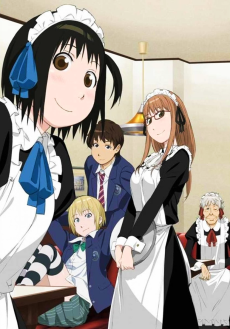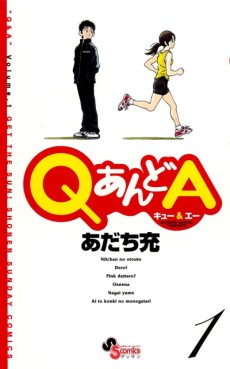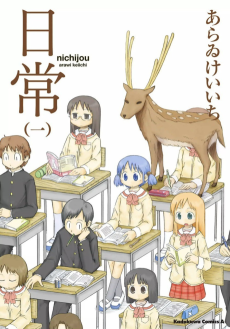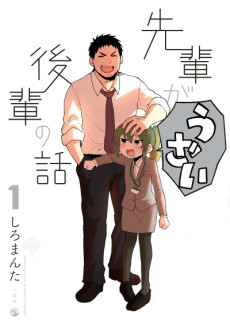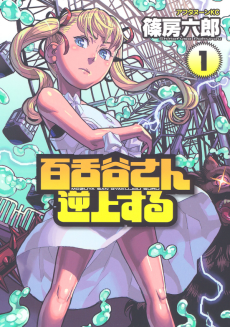SOREDEMO MACHI WA MAWATTEIRU
STATUS
COMPLETE
VOLUMES
16
RELEASE
October 28, 2016
CHAPTERS
138
DESCRIPTION
There is a small maid cafe that nearly nobody goes to – Maid Cafe Seaside, quiet enough for Sanada to do his homework in. His airheaded classmate Arashiyama works as the cafe’s only maid, even though she sure doesn’t act like one. What happens when her friends stop by for a visit?
(Source: Manga Planet)
Notes: Nominated to the 22nd Annual Tezuka Osamu Cultural Prize.
CAST
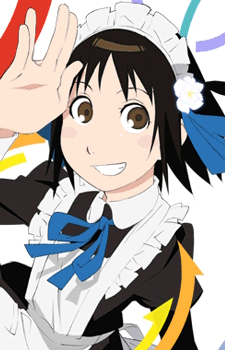
Hotori Arashiyama
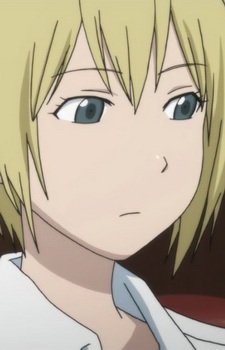
Futaba Kon
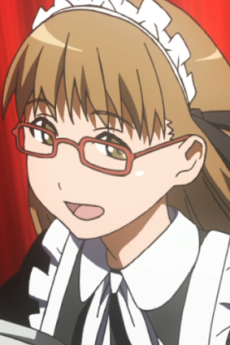
Toshiko Tatsuno
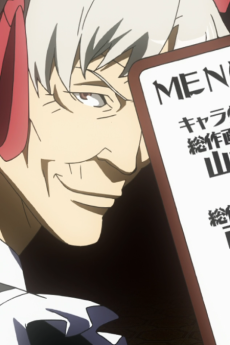
Uki Isohata
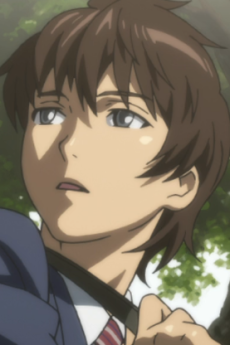
Hiroyuki Sanada
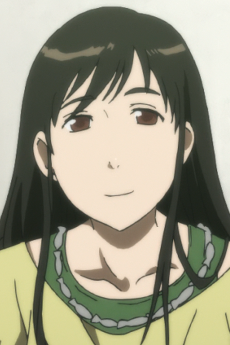
Shizuka Kameidou
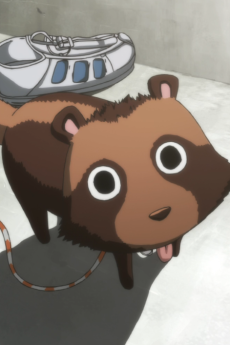
Josephine
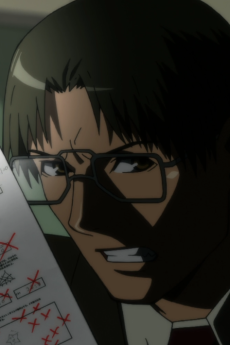
Natsuhiko Moriaki
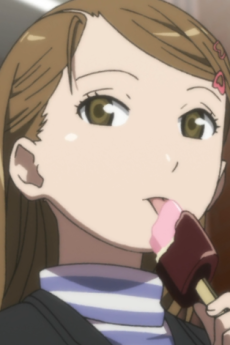
Eri Isezaki
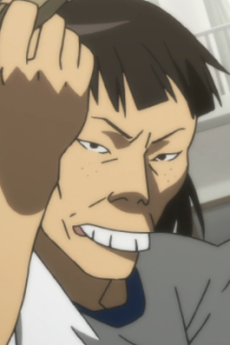
Harue Haribara
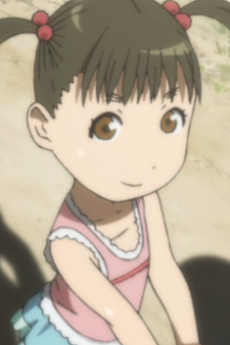
Yukiko Arashiyama
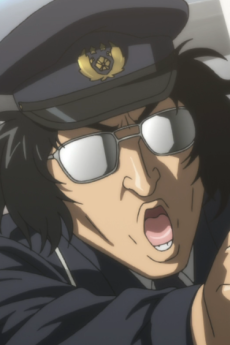
Shunsaku Matsuda
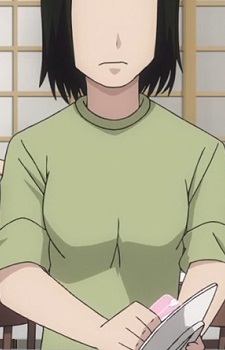
Yukimi Arashiyama
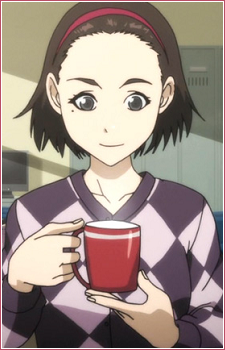
Nishi
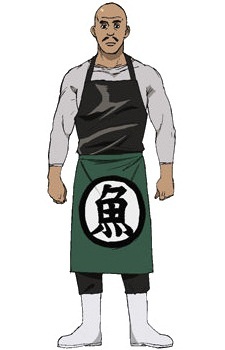
Yuuji Sanada
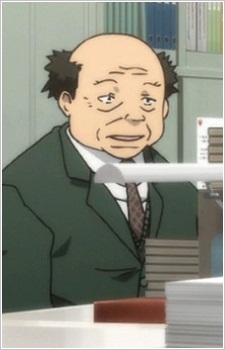
Kameda

Tsutomu Serizawa
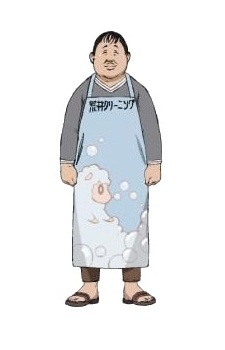
Kazutoyo Arai
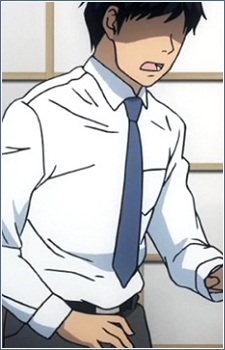
Ayumu Arashiyama
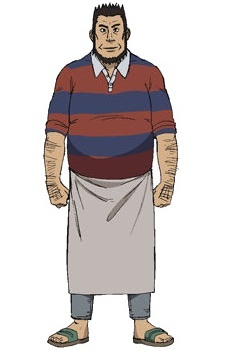
Takanori Kikuchi
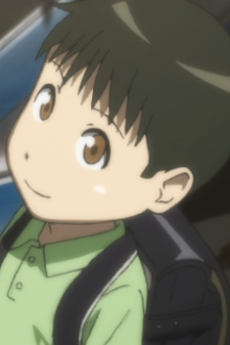
Takeru Arashiyama
CHAPTERS
RELATED TO SOREDEMO MACHI WA MAWATTEIRU
REVIEWS

saulgoodman
90/100Piping hot with comedy, mystery, supernatural & a dysfunctional maid detective; the town, indeed, keeps moving.Continue on AniListDuring my on-going quest to complete Studio SHAFT's (ALL CAPS WHEN YOU SPELL THE NAME) works recently, I had a very fortunate encounter with And Yet, The Town Moves. But to save the anime review for another time, I'm grateful to Shinbou and the other SHAFT staff for such a great adaptation of a great series. Their trademark unconventional directing complemented its quirkiness and mystification, successfully getting me to read the manga after finishing the anime. And as a heavy slice-of-life consumer, I was not disappointed.
Skip to the end for a short, spoiler-free review

Maid-o! Despite its mundane premise, And Yet, The Town Moves is anything but. After reading for a few volumes, you'll be sure to notice the various quirks and dysfunctionality of this series.
And Yet, The Town Moves is a steaming hotpot of jumbling genres, ingredients including slice-of-life, mystery and supernatural. And with its rich plot and characters, And Yet, The Town Moves relentlessly assaults the readers with many peculiar and humorous subplots. Admittedly, I found the supernatural aspect somewhat lacking compared to its other two genre peers. However, that didn't hinder my appreciation and enjoyment of its slice-of-life and mystery in the least.
Before discussing any of that, however, it's invaluable to mention that the story is in unchronological order. Meaning, it's roughly an episodic series at first glance but has connecting threads. Whether you see this as an incohesive mess or a fun puzzle, like me, is entirely understandable. After reading for a few dozen chapters, you'll notice that the story is indeed out of order, from small details like Arashiyama's hair changing length or character dynamics suddenly regressing or progressing. I heard that the author included, or someone figured out the chronological order of events but I haven't discovered it.
And Yet, The Town Moves excels as a comedic slice-of-life. Initially limited to Arashiyama's trivial goof-offs in Café Seaside and at school, the series expands to a number of different plotlines as it progresses. There's some short-and-sweet, like Uki's late husband wandering around, and others that grow with time, such as Takeru and Eri's budding romance. And contrary to the general lighthearted nature, it'd be a bit of a disservice to call And Yet, The Town Moves bombastic. There's occasionally an unexpected emotional quaintness, adding depth to the characters development, then immediately shying away from that short burst of pathos, and returning back to the comedy. To lightly speak on it, the characters heavily uphold the situational comedy. Their varying personalities and compatible dynamics with many others guarantee that even characters who rarely interact will muster a smirk or two from the readers. In short, contrary to the mundanity of town life, And Yet, The Town Moves easily manages to depict a fictitious world bustling with the lives of its many fun residents and their daily situations that often go out-of-hand.
Before talking about the mystery aspect, it's again worth noting the unchronological order of events in this series. This unorthodoxy may put some readers off, but I enjoyed it and found it added depth to the dysfunctionality and mystery. And who better embodies these two elements than the enigmatic maid herself? Arashiyama's dream to become a detective and her passion for mystery novels frequently serves as chapter plots, shining a surprisingly adept light on her otherwise goofy character. The mysteries are usually mundane, revolving around school, the café or home, yet very entertaining to witness unfold and conclude due to Arashiyama's erratic behavior.
My least favorite genre aspect is the supernatural. It's lacking compared to the other two, understandably so in order to supplement the mystery aspect. The few supernatural subplots were entertaining enough for me to yearn for more, but only to receive a disappointingly lack of. The aliens and time-travel were entertaining and interesting chapters, but I found the whole "God-gives-you-the-red-or-blue-pill" situation towards the end somewhat lackluster and a cheesy attempt to conclude the story.

Kon and Arashiyama Though And Yet, The Town Moves tends to not stray away from its comedic essence, the most defining of its shy sentimental side is Futaba Kon's development, both in her character and relationship with Arashiyama.
Kon isn't thoroughly characterized outside of her rock-and-roll passion, pseudo-delinquency, and immense ping-pong talent for some time. Though, not to suggest that this makes her a bland character. Her screen-time goofing off with Arashiyama and her personality flipping between low-strung and irritated made for entertainment. However, as the story progresses later on, her characterization blooms and development made more apparent as her screen-time occasionally detaches itself from the comedic tone and delves into Kon's lonely, walled-off world.
Because Arayshiyama's the protagonist of the story, Kon's isolation wasn't as visible for a while. Even though there were clear hints propagating this idea throughout the story, such as the fact that Kon lives by herself and that she always eats on the rooftop of the school during lunch, Arashiyama's zaniness bested out the solemnness of Kon's character during these scenes.
In her few standalone scenes, Kon's interactions with others illustrates the extent of her self-isolation. Her naturally intimidating appearance, a combination of her piercing glare, haughty manner of talking and dyed blonde hair, has shunned away her classmates, often leading to misunderstandings about Kon's character. Though her contrastingly sweet side is frequently seen, such as taking care of her cat and affectionately calling her parents "Mama" and "Papa", Kon doesn't bother to form any bonds with her classmates close enough to see her softer image. Or rather, she intentionally thwarts them off.
Much deeper into the story, it finally reveals Kon's past. She was quite shy as a middle-schooler, becoming friends with an upperclassman in the table tennis club and joined it. Though Kon only talked to her, similarly to how Kon presently talked to Arashiyama, it wasn't out of malice or distrust of others. However, as Kon's exponential talent bested out everyone in the club, including her friend, she received frequent harassment. And even her own saving grace, her upperclassman friend, joined in on the bullying, effectively encasing Kon in a self-dependent and defensive armor. Though some attempted to break open her armor, like Haribara, it was always to no avail. However, Arashiyama managed to slip through a chink in her armor and once again shows Kon how colorful the world outside her walled-off world is.
Arayshiyama's natural disposition to barge in anyone's business worked effectively even with Kon's hardened and defensive personality. Strutting into Kon's apartment as if it's her own soon becomes natural, though Arashiyama is still met with angry backlash. But these rather annoying and protrusive mannerisms are what slowly resolve Kon's Hedgehog's Dilemma. Another brief flashback chapter reveals the context behind Kon and Arashiyama's habitual rooftop lunch meetups. Originally a physical manifestation of her closed-off world, Kon timidly offers to share the rooftop with Arayshiyama, who had no where to go for lunch on a day that her friends weren't present. And realizing that Arashiyama would go back to regularly eating with her friends, Kon expresses subtle melancholy, quickly dissipated when Arashiyama asks if they could eat together again. Though a bitter one, Arashiyama is the medicine Kon needed. However, swallowing the Arashiyama Pill wasn't always smooth.
Kon's defensive personality occasionally manifested through irritated backlash against Arashiyama's unintentionally provoking words and actions. Her livelihood and socializing urges often conflicted with Kon's asocial and apathetic, bordered world. But little by little, these tense moments provided Kon with wistful and guilty introspections, usually ending with her begrudgingly accepting Arashiyama.
And towards the end, a few scenes outline Kon's growth. One such scene was the athletics festival. It simultaneously features the extent of Arashiyama and Kon's friendship and Kon's personal growth. As the relay race approached, Arashiyama finds Kon once again coolly sheltering herself at the school rooftop, under the shadow of a massive balloon. After exchanging some words, Arashiyama returns back to participate in the relay, but soon panics when the balloon collapses, rushing off to check on Kon. However, unbeknownst to her, Kon had already left to also participate in the relay. Though met with skepticism and distrustful stares from her class, Kon blows away their expectations as she easily wins the relay. As she's met with praise from her classmates, Kon's growth is heartwarmingly apparent. Though she could've simply stowed away at the school rooftop as usual, she chose to metaphorically break away from her isolative residence, to a place full of interpersonal and mutual trust. And though she's experienced backlash and pain from showcasing her physical talent, she has no qualms or hesitation going all out during the relay.
Additional scenes depict how Arashiyama helps break Kon away from her world, who begins to take initiative herself. Arashiyama forcibly takes Kon to her table tennis club in order to explain why she's going to miss practice in order to find her missing cat. Had she been alone, Kon would've simply left the misunderstandings of her absence garner distrust from her peers. But once Arashiyama has her explain, Kon is surprised to hear her captain's empathy towards her situation. And other similar scenes illustrate how Kon regains her trust and reliability on others as she interacts with new people through Arashiyama's extremely sociable nature.
The unchronological nature of this series would seemingly hinder and perplex a chronological process like character and relationship development, but I personally didn't find it an obstacle. There were only a couple of scenes, like Kon suddenly being shy of Takeru after a previous scene of her playfully teasing him, that garnered mild confusion, but it was still easy to piece together the stages of development.
In the midst of the eccentricity of this series, Kon and Arashiyama's dynamic was one surprising and pleasant to see unfold. While the comedic absurdism dominates the tone, splashes of sentimentality stain the story occasionally.

And Yet, The Town Moves An overarching, somber sentiment to And Yet, The Town Moves is this sense of phantom nostalgia, a lingering bitter sweetness, homey longing for the passing halcyon days. Despite how close-knit and strong the town is, despite the dysfunctional extent of Arayshiyama's antics, The Town Moves.
Even though I'm a purebred city kid, stories like this and Barakamon situated in rural/suburban town settings somehow manage to give me stronger tastes of nostalgia than my own reflections of my past. It's mostly due to how well they portray a strong sense of community, belonginess and traditions that may be lost on most of us city dwellers. And this series' cast embodies these homey sentiments that I adore. Nearly every character are connected with each other and have great, familial chemistry in their interactions and conversations. It's great to see the mom-and-pop shops supporting each other and having known each other since their youth. And no one more than Arashiyama has a stronger communal sentiment, as she swimmingly interacts with just about any one in her town. If anything, it's as if she's the town deity, dedicating herself to uphold the town's spirit, comradery and traditions.
However, even this eccentric detective can't halt the passage of time. As chain stores infest her town and slowly put the hometown ramen business that she's frequented since her infantile days, she despairingly persuades others to keep it afloat by supporting it and boycotting the former. And in rare bouts of seriousness, she wistfully muses over her childhood memories. Her elementary school's rooms have changed and the once massive playground is now small to her. Or rather, Arashiyama simply grew up. Despite our differing homes and environments, everyone shares this exact same nostalgic despair. Seemingly insignificant changes like quaint businesses shutting down and new ones opening up, restructured public facilities, old faces replaced by new ones, can be difficult pills to swallow.
Even time traveling can't stop inevitable change. Nor dimension-warping aliens. Neither do urban legend ghosts. And certainly not Arashiyama's death. God himself could cast his powers on her humble abode to keep it from changing, and yet, the town moves.

Conclusion And Yet, The Town Moves is a genre hybrid of mystery, comedy, slice-of-life and supernatural. Regardless of the fact that I found some of these aspects executed weakly than others, I've smoothly managed to hold massive adoration for the peculiar sleuth known as Arashiyama and her quaint town, both full of mundane nothings and eccentricities.
The characters pop with memorable quirks and personalities, making their interactions and conversations all the more livelier and amusing. Perhaps you're dubious at the prospects of sincere character dynamics and development, but you might find yourself in for a mild treat. Though it's primarily centered around Arashiyama and Kon, their relationship consequentially driving the development of Kon came as a pleasant surprise in the midst of the absurd comedy. Transparent or opaque, you may find their relationship either the centerfold main course or an after-meal dessert. But don't let this lead you to believe that the numerous other relationships in this story are sidelined. Arashiyama's naturally annoying charisma attracts many different folks, and you'll be sure to enjoy any conversation she has.
The story's told in an unchronological order, whether you find that a weakness or strength. For myself, it added immensely to my enjoyment and the story's mystery. However, if you pay a measly moderate amount of attention, you won't be endlessly navigating and confused. Subplots lasting more than one or two chapters are generally told in consecutive order, so you won't be lost connecting those points.
My comments on the art are bareboned. Character designs are well-suited for the general lighthearted, comedic tone; with their frequent animated expressions and plain looks. Just what I'd expect from a slice-of-life series, and I'm satisfied with it.
As for my last comment, I have to say that this series has one of my favorite titles in the manga medium; "And Yet, The Town Moves". There's a fine symmetry between vague and descriptive that I steadily became aware of as I kept reading. This strange, cut-off sentence of a title entranced me into watching the anime. In spite of who, what, when, where; does the town keep moving? But in fact, this vagueness beautifully embodies this 16-volume story with just those 5 words. Despite the mundane or supernatural, uneventful or eventful, rainy or sunny, red or blue; the town keeps moving. Nothing can stop the course of time and inevitability of change, for better or worse. In a nutshell, And Yet, The Town Moves is about everything that has, could, can, might, may and will occur, and yet, the town moves.
I've also written a review for the anime, as well. Please check it out if you're interested!


GustavoSchiavon
100/100Um Manga que merecia muito mais que só adaptação de 12 episódiosContinue on AniList
Acho que é um ótimo Manga para eu fazer meu "primeiro" review de mangá da vida, fazia um tempo que eu só ficava na vontade de ler manga e ficava meio travado porque eu dei uma pausa de uns 6 ~ 7 anos no One Piece (que acabei fazendo uma review que, na verdade, era mais para comemorar que eu tinha chegado no capítulo 1000) para esperar lançar mais kkkkkkkkk, como que chegou na "saga final" eu voltei e comecei um sistema novo de ler manga que acabou virando uma bola de neve me levando a reler bleach e ler esse manga entre outros.

Esse manga não é minha primeira vez com a história, primeiro eu ganhei na loteria baixando o anime tanto dele quanto o Tengoku Daimakyo na mesma "batch" sem nem saber que era do mesmo autor, até fui um dos 4 que fez review do anime e vou ser, por agora, o segundo a fazer um Review do Manga. Primeiramente, estava mais com vontade de ler o Manga do Tengoku porque tinha gostado muito da história e queria ver o que acontecia depois do anime, mas descobri que o manga do SoreMachi é bem mais profundo por um vídeo no YouTube e acabei trazendo ele junto para a festa.

Falar sobre a sinopse desse manga é um negócio muito difícil, quase como andar num labirinto. Ele é uma manga acronológico, uma coisa que pode confundir de começo, mas acaba ajudando a prestar mais atenção na história. De começo, ele é bem mais linear que o anime, que parece que só tacou os capítulos para cima e foi pegando os aleatórios para adaptar (mas isso é uma coisa que vou deixar para falar mais sobre daqui a pouco), mas a partir do capítulo ~40 ele vira mais episódico, se der para falar isso de um Manga.

Ele se passa durante os 3 anos de ensino médio da Hotori, uma personagem que eu já tinha gostado no anime que ela era mais uma doidinha burrinha que amei o fato de ela ter sido dublada pela mesma dubladora da Maka de soul eater, mas é no Manga que ela desbloqueia o potencial. No anime às vezes tinha um pouco de ela ser detetive, mas achava que era mais para piada enquanto no Manga é todo o negócio dela, ela é simplesmente um bookworn de livros de mistérios e com essas influências ela se mostra bem astuta ao fato de conseguir resolver diversos mistérios que o anime nem chegou perto de adaptar infelizmente. Ela tem um arco muito foda que quando tu acha que acaba ele vai e fica melhor e como o Manga tem essa natureza acronológica a gente começa a ver a construção de carácter dela entre diferentes perspectiva e em tempos diferentes que só vai deixando cada vez mais aparente como ela muda e não muda com o tempo, uma coisa que a gente vê muitos com todos os personagens e meio que o ponto principal da história: Como que não importa o quanto a gente mude a... cidade continua se movendo... alá falei o nome do Manga

Difícil falar de história sem falar da principal, então acabei indo mais para o lado dela, já que fui desse jeito tá na hora de falar dos personagens, muitos personagens que são super legal no Manga e mal aparecem no anime e os que apareceram às vezes nem teve muito oque falar, como faz tempo que vi o anime não acho que vou fazer muita comparação pelo simples motivo que eu não vou me lembrar 100% das diferenças e muito nem importa muito

A Tatsuno Toshiko, também conhecida como maid #2 ou ta-tsun, começa mais como o "straigh man" da dupla de maid do café seaside, de primeira ela vira mentora e tenta ensinar a Hotori a como ser uma maid de verdade, logo depois a gente descobre que ela é meio que um otaku, mas se tu prestar atenção como parte assim sempre teve meio que na cara que ela era um pouco no mínimo. O pretexto de ela "trabalhar" no café era esse, mas ela acaba ficando mais porque o Sanada, quem ela ama (que só depois a gente recebe mais contexto) é um regular, que ele é porque ele ama a Hotori kkkkkkkkkkk, ai eu volto ao meu ponto que é muito difícil falar da história porque tem muita situação assim que vira um labirinto.

Muito engraçado a dinâmica dela com todos os personagens, que como a Hotori ela tem muitas conexões com todo mundo. Ao passar do tempo ela vai se assimilando cada vez mais a Hotori por passar tanto tempo com ela já que ela trabalha com ela, além disso, a opinião sobre ela acaba sendo traduzida pela Hotori então todo mundo acaba conhecendo ela pela mente de outra pessoa, por causa disso o apelido dado a ela pela Hotori acaba virando um segundo nome, muito engraçado isso do apelido Ta-tsun, me lembra muito como que várias pessoas já trocaram o nick para um jeito que falei errado zuando, não sabia que era algo comum assim.

O Sanada foi o personagem que eu mais gostei da diferença entre o anime e o manga, ele tem o mesmo problema que eu com a habilidade de escrever, não sei como pode ser tão difícil. Muito legal ele querer começar um diário, mas não sabia o que escrever, daí decidiu se melhorar nesse quesito. Eu sei como que é essa luta.


Ele sempre tem uma fantasia com a Hotori, uma maior que a outra, mas o coitado sempre acaba não conseguindo realizar elas porque ele fica mais pensando doque fazendo, que dor no coração que dá ver que ele não consegue usar uma. O coitado se espatifa tudo quando tenta fazer uma coisa.

No anime, ele está sempre na mesma parece, mas no Manga ele tem bastante parte divertida e legal. Foi com ele que aconteceu uma das primeiras partes mais profundas do Manga, que caiu como se fosse um soco na cara para me lembrar que esse manga não era só mais um mangazinho de comédia. Também é engraçado como que ele parece mais um filho de cachorro molhado aqui doque no anime kkkkkkkkk

A Vozinha louca empreguete acho que foi uma das personagens mais bem-adaptadas do anime, não parece que tem tanta coisa a acrescentar já que ela é mais um "outside observer" na história doque alguém que realmente "é um personagem". Ela acaba se dando bem com a ta-tsun de tanto as duas reclamarem da hotori kkkkkkkkk


Josephine, o cachorro, agora tem outro nome... pon-chan

A Kon e a Shizuka acabaram tendo MUITA, mas MUITA mesmo, mais coisa como personagem, com muitas partes que ela até viraram mais protagonistas que a Hotori, coisa que acho que ninguém que assistiu ao anime deve ter esperado. Porque, por exemplo, a Shizuka é "só" a mulher que cuida da loja de antiguidades de seu avô no anime, enquanto o bulk de o que faz a manga ser especial é diretamente culpa dela. A Kon era para ser só uma senpai da hotori que também morava perto, mas acaba sendo a mais afetada pela Hotori.
Um mini Spoiler, Muito loco como que as duas estão juntas no universo que a hotori não existe
Eu já gostava bastante da Kon do anime, mas amei demais o personagem dela no Manga, ela é aquele tipo de pessoa que por dentro é uma criança curiosa, cheia de vontade de brincar, mas tenta se distanciar devido a um trauma. Esse Review(o único outro do Manga kkkkkk) fala muito bem sobre, eu ia deixar mais para o final para falar sobre ele, mas vou mencionar aqui e completar mais tarde.



Muito legal ver ela se abrindo para a hotori, de começo às vezes ela parece já conhecer o Irmão da hotori, o Takeru, mas depois que a gente descobre como os dois se conheceram e como ela é fofinha ao lado da família da Hotori. Ela é a personagem com o maior "nível de evolução na história inteira", é difícil para ela se abrir com os outros, mas quanto ela se abre, ela fica muito fofinha, muito legal as aventuras que ela é mais levada à força pela Hotori, mas ela acaba aproveitando bastante.


A Shizuka também tem um alto "nível de evolução na história", mas acontece meio que mais antes da história começar, as partes que ela é meio que a protagonista são uma das melhores, muito foda a visão que do mundo que ela tem. Muito engraçado a hotori ser do jeito que é porque ela virou uma cobaia para a Shizuka quando ela era criança kkkkkkkk, ela querer ler uma novela que ela escreveu sem saber que foi ela que escreveu foi o total estopim da história.

Amo muito os "insights" que ela dá para Hotori em questão de escrita, ressoou comigo tanto quanto a do sanada. Foi com ela que descobri como: muita coisa como anime e manga tem sempre aquele personagem que é só o autor se enfiando na história para movimentar ela, nesse parece que meio todo mundo é. Me lembra muito quando tenho ideia de fazer alguma coisa e imagino uma conversa com pessoas que conheço sobre o mesmo assunto. O Manga parece ser muito isso, um exercício para movimentar a história e por isso funciona quando se taca mil gêneros junto kkkkkk

De resto de personagem eu acho difícil achar oque falar, loucura a quantidade que não tem "creditado" no Anilist, mas um bate bola jogo rápido e personagem que não tinha aparecido muito no anime aqui não aparece tão mais e personagem que só tem no Manga também não aparece muito então não é tão problema. Queria falar mais de personagem, mas como falei, tenho problema de escrever e não anotei muito sobre os personagens, mas mais sobre a história e temas.

A arte do Manga de primeira não me pegou muito, muitos personagens são iguais ao anime, a ta-tsun de começo no Manga parecia ter uma aparecência mais "genérica", não era tão bonita, mas também não acho que era para totalmente ser a mais bonita de todas porque ela é mais uma colegial normal doque uma modelo, então acabou que o visual dela no anime acabou parecendo mais genérico igual a do Sanada que parece ser só uma personagem genérico da SHAFT, não que seja ruim claro, de resto o Manga é muito bonito, ele não mostra muita paisagem e é mais sobre personagem conversando, mas quando mostra uma coisa é bem bonita. O anime parece que só pegou os designing direto do Manga, tirando a Ta-tsun e o Sanada por algum motivo estranho. Outra diferença entre o anime e o manga nesse quesito é o echii, que o máximo que tem no Manga é às vezes mostrar um pouco da calcinha das personagens, mas nada muito explícito.

O que eu mais anotei era sobre coisa mais a ver com o tema do anime, então vou deixar mais essa parte sobre isso. Dá uma raiva ver coisa que acontece no anime demorar para acontecer e coisa super legal ter no Manga, mas não no anime, que escolha estranha de fazer as coisas, mesmo os dois sendo acronológicos, o anime parece que só tacou os capítulos para cima e pegou uns aleatórios para adaptar. Muito estranho do nada tomar jumpscare de uma parte adaptada no anime, após capítulos "novos" para mim, do nada apareceu um que eu já vi.

Um ponto sempre tocado na história é sobre memória e amor junto num contexto de "melhoramento", meio que dá um soco na cara às vezes fazendo a gente se lembrar como que o manga não é só um mangazinho de humor e é bem mais "deep", o manga sempre bate com umas coisas profundos, muito triste não ter muito disso no anime e só considerar a hotori com uma doidinha burrinha, que ela é um pouco, mas também tem seus momentos.


Pelas mensagens de final de volume parece que cada volume tem um tema, mas parece que são tão abrangentes que só vejo quando eu leio ele falando sobre o tema kkkkkkkk, também não é como se eu tivesse lendo o físico e soubesse quando exatamente um volume termina e outro continuo já que os capítulos só vão continuando e às vezes tem uma capa colorida que eu não fico mais que um minuto nela.

Tem muita parte engraçada dividida em duas páginas durante um capítulo que fica ruim de printar e compartilhar, mas até é bom porque é um spoiler para quem não leu, mas porra elas tão sempre arrancando risadas da minha goela.

Para finalizar acho que não tem muita coisa para falar após fazer um Review de 10mil carácter que mal dá de entender oque eu tô falando kkkkkk, de nota obviamente vai para a máxima, amei demais como as coisas foram acontecendo e só me deu mais hype para o vai acontecer no próximo manga que eu vou ler do mesmo autor. Também coloquei no meu pequeno canto de mangas favoritos, que eu já pensei em colocar logo no começo e cada vez que eu lia me fazia gostar mais ainda.

Quase me esqueci, mas recomendo muito esse review, ele fala muito bem muita coisa que eu queria falar melhor"Though a bitter one, Arashiyama is the medicine Kon needed. However, swallowing the Arashiyama Pill wasn't always smooth."

E também esse vídeo do YouTube, que foi oque me fez querer ler o Manga
Quase conseguir usar todas as print que tirei do manga e salvei no Imgur, dump do resto com começando com a Kon imitando eu lendo o manga





SIMILAR MANGAS YOU MAY LIKE
 MANGA ComedyMoyashimon
MANGA ComedyMoyashimon MANGA Sci-FiYokohama Kaidashi Kikou
MANGA Sci-FiYokohama Kaidashi Kikou MANGA ComedyYotsuba to!
MANGA ComedyYotsuba to!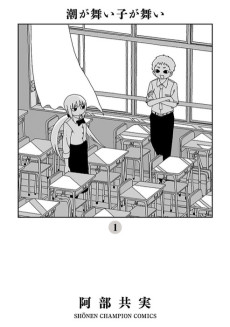 MANGA ComedyShio ga Mai Ko ga Mai
MANGA ComedyShio ga Mai Ko ga Mai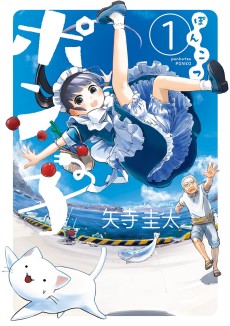 MANGA ComedyPonkotsu Ponko
MANGA ComedyPonkotsu Ponko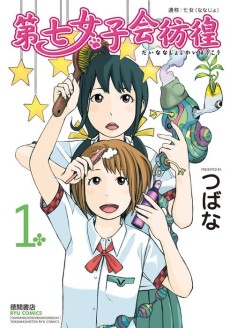 MANGA ComedyDainana Joshikai Houkou
MANGA ComedyDainana Joshikai Houkou
SCORE
- (4.05/5)
MORE INFO
Ended inOctober 28, 2016
Favorited by 311 Users


